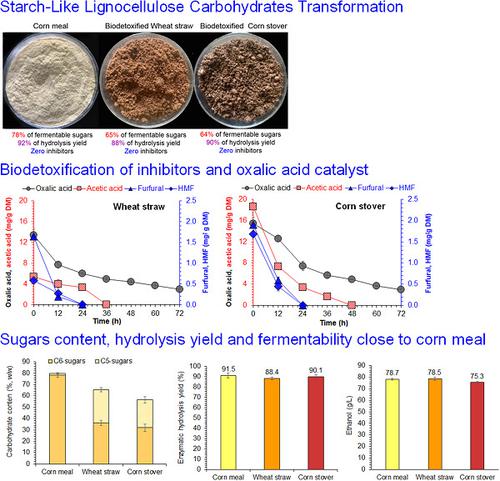当前位置:
X-MOL 学术
›
Biotechnol. Bioeng.
›
论文详情
Our official English website, www.x-mol.net, welcomes your
feedback! (Note: you will need to create a separate account there.)
Transformation of lignocellulose to starch-like carbohydrates by organic acid-catalyzed pretreatment and biological detoxification
Biotechnology and Bioengineering ( IF 3.5 ) Pub Date : 2021-07-13 , DOI: 10.1002/bit.27887 Bin Zhang 1 , Faryal A Khushik 1 , Baorui Zhan 1 , Jie Bao 1
Biotechnology and Bioengineering ( IF 3.5 ) Pub Date : 2021-07-13 , DOI: 10.1002/bit.27887 Bin Zhang 1 , Faryal A Khushik 1 , Baorui Zhan 1 , Jie Bao 1
Affiliation

|
Corn dry milling provides a mature model for lignocellulose biorefinery process. To copy this technical success, a crucial step is to transform lignocellulose into starch-like carbohydrates (SLC), similar to milled corn grain and in a similar fashion to corn dry milling. The transformation process should be zero wastewater generation and sufficient fermentable sugar conservation; the product should be in solid particle form, free of toxic residues, and high enzymatic hydrolysis yield and fermentability. Here we designed and verified a SLC transformation process by (i) biodegradable oxalic acid-catalyzed pretreatment, and (ii) simultaneous biodegradation of inhibitors and oxalic acid catalyst. The oxalic acid catalyst was effective on disrupting the lignocellulose structure and also biodegradable at low pH value. The biodetoxification fungus Paecilomyces variotii FN89 was capable of degrading the furan/phenolic aldehydes and oxalic acid simultaneously and ultimately, while the fermentable sugars were well preserved. The obtained SLC from wheat straw and corn stover were similar to dry milled corn meal in terms of morphological properties, fermentable sugar contents, enzymatic hydrolysis yield, elemental contents, and free of inhibitors and acid catalyst. The bioconversion of starch-like wheat straw and corn stover produced 78.5 and 75.3 g/L of ethanol (9.9% and 9.5%, v/v) with the yield of 0.47 and 0.45 g ethanol/g cellulose/xylose, respectively, compared with 78.7 g/L (10.0%, v/v) from corn meal and the yield of 0.48 g ethanol/g starch. Mass balances suggest that the ethanol yield, wastewater generation, and elemental recycling of the SLC from lignocellulose were essentially the same as those of corn meal.
中文翻译:

有机酸催化预处理和生物解毒将木质纤维素转化为类淀粉碳水化合物
玉米干磨为木质纤维素生物精炼工艺提供了成熟的模型。为了复制这一技术上的成功,关键的一步是将木质纤维素转化为淀粉样碳水化合物 (SLC),类似于碾磨的玉米粒,并以类似于玉米干磨的方式。改造过程应实现零废水产生和充分的可发酵糖保存;产品应为固体颗粒状,无毒残留,酶解产率和发酵性高。在这里,我们通过 (i) 可生物降解的草酸催化预处理和 (ii) 抑制剂和草酸催化剂的同时生物降解设计并验证了 SLC 转化过程。草酸催化剂可有效破坏木质纤维素结构,并且在低 pH 值下也可生物降解。生物解毒真菌拟青霉FN89能够同时并最终降解呋喃/酚醛和草酸,而可发酵的糖类被很好地保存。从小麦秸秆和玉米秸秆中获得的SLC在形态特性、可发酵糖含量、酶解产率、元素含量等方面与干磨玉米粉相似,且不含抑制剂和酸催化剂。类淀粉麦秸和玉米秸秆的生物转化产生了 78.5 和 75.3 g/L 的乙醇(9.9% 和 9.5%,v/v),产量分别为 0.47 和 0.45 g 乙醇/g 纤维素/木糖。来自玉米粉的 78.7 g/L (10.0%, v/v) 和 0.48 g 乙醇/g 淀粉的产量。质量平衡表明乙醇产量、废水产生、
更新日期:2021-09-12
中文翻译:

有机酸催化预处理和生物解毒将木质纤维素转化为类淀粉碳水化合物
玉米干磨为木质纤维素生物精炼工艺提供了成熟的模型。为了复制这一技术上的成功,关键的一步是将木质纤维素转化为淀粉样碳水化合物 (SLC),类似于碾磨的玉米粒,并以类似于玉米干磨的方式。改造过程应实现零废水产生和充分的可发酵糖保存;产品应为固体颗粒状,无毒残留,酶解产率和发酵性高。在这里,我们通过 (i) 可生物降解的草酸催化预处理和 (ii) 抑制剂和草酸催化剂的同时生物降解设计并验证了 SLC 转化过程。草酸催化剂可有效破坏木质纤维素结构,并且在低 pH 值下也可生物降解。生物解毒真菌拟青霉FN89能够同时并最终降解呋喃/酚醛和草酸,而可发酵的糖类被很好地保存。从小麦秸秆和玉米秸秆中获得的SLC在形态特性、可发酵糖含量、酶解产率、元素含量等方面与干磨玉米粉相似,且不含抑制剂和酸催化剂。类淀粉麦秸和玉米秸秆的生物转化产生了 78.5 和 75.3 g/L 的乙醇(9.9% 和 9.5%,v/v),产量分别为 0.47 和 0.45 g 乙醇/g 纤维素/木糖。来自玉米粉的 78.7 g/L (10.0%, v/v) 和 0.48 g 乙醇/g 淀粉的产量。质量平衡表明乙醇产量、废水产生、











































 京公网安备 11010802027423号
京公网安备 11010802027423号